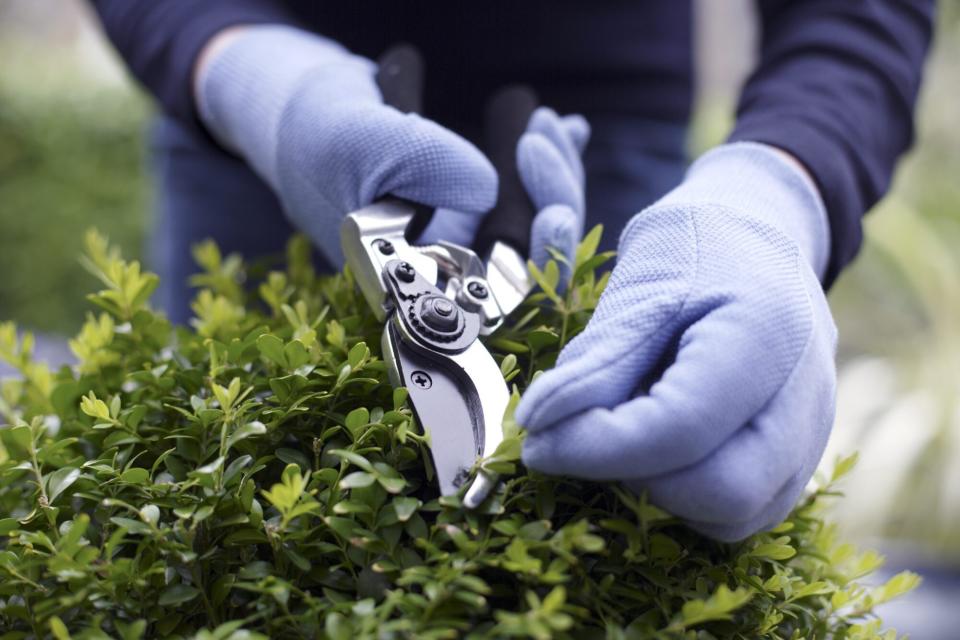What to Know About Different Types of Pruning Cuts
We gardeners need haircuts every so often, and so do our plants. While we can't load up our plants and take them to the salon, we can give them individualized cuts, trims, and shapes at home. There are as many styles of pruning as there are gardeners wielding shears, but we've narrowed it down to a few basic types of cuts you should know about. Learn the different kinds of snips you might need to make, from basic pruning to precise cuttings, so that you'll be ready when it's time to break out the garden shears, loppers, and saws. Once you've learned about the cuts, find out when to prune the flowers and shrubs in your garden (including crepe myrtles!).

IAN HOOTON/SPL/Getty Images
Taking Cuttings
If you'd like to take a portion of a plant to propagate a new one or pass along to a friend, you'll want to make a cutting. For most plants, you'll need to use small shears to snip off a section of the plant. Be sure to include a good portion of the stem and foliage at the base of a leaf. The cut should be made just below a root node, which is the part of the plant that will send out roots and cause new growth to take root. Once you've mastered the cut, learn how to propagate plants from your new cuttings.
Pinching
This type of cut doesn't involve shears. To do it, you'll pinch off a bud with your fingers. This is done on terminal buds to remove growth and encourage a plant to grow bushy rather than leggy. Often done on small shrubs and flowers, pinching helps shape a plant and control its growth.
Deadheading
Most gardeners will be familiar with this type of pruning. According to the Penn State Extension, "Deadheading is a process of pruning by which old growth and seed heads are removed from the plant to promote new growth and re-flowering. Deadheading is very simple. As blooms fade, pinch or cut off the flower stems below the spent flowers and just above the first set of full, healthy leaves." This effort takes off wilted flowers and encourages plants to redirect their energy to new growth.
Thinning Cuts
Thinning cuts take out whole shoots of a plant to decrease the general thickness of its foliage. This type of cutting is not done to encourage regrowth; instead, thinning takes out whole shoots, stems, and branches where they meet larger parent branches. Thinning doesn't typically change the shape of the plant, but it does result in fewer branches overall, which can increase air circulation through the foliage.
Shaping Cuts
Cutting plants with a focus on shaping is a technique most often seen in topiary. It's a popular strategy for boxwood and evergreen plants, and it usually involves first snipping a plant into an initial rough shape, then shearing and trimming for precision. Other pruning cuts can result in altered shapes for the plants being pruned, but that's not their sole intention.
Heading Cuts
According to IFAS at the University of Florida, "A heading cut is a type of pruning cut that prunes a shoot no more than two years old back to a bud; cutting through an older stem back to a lateral branch less than 1/3 the diameter of the cut stem; or cutting a stem to an indiscriminate length." This is usually done to remove just a part of a shoot of growth. It's often done to slow the vertical growth of trees or other plants and encourage thick, dense lateral growth.
Reduction Cuts
According to the Colorado State University Cooperative Extension, "Reduction cuts remove a larger branch or trunk back to a smaller-diameter side branch. Reduction cuts are commonly used in training young trees. They are also the only type of cut that will significantly lower a tree's height." It's not a good idea to do these cuts on established, mature trees because they can destabilize them.
What types of pruning cuts do you do in your garden? What's your go-to set of tools for pruning?

